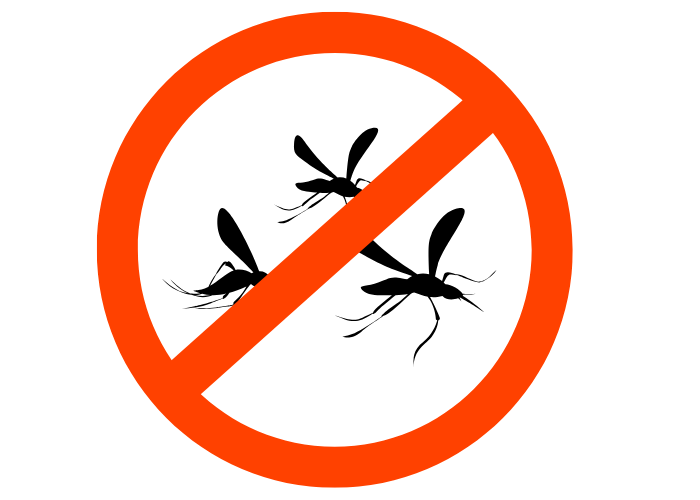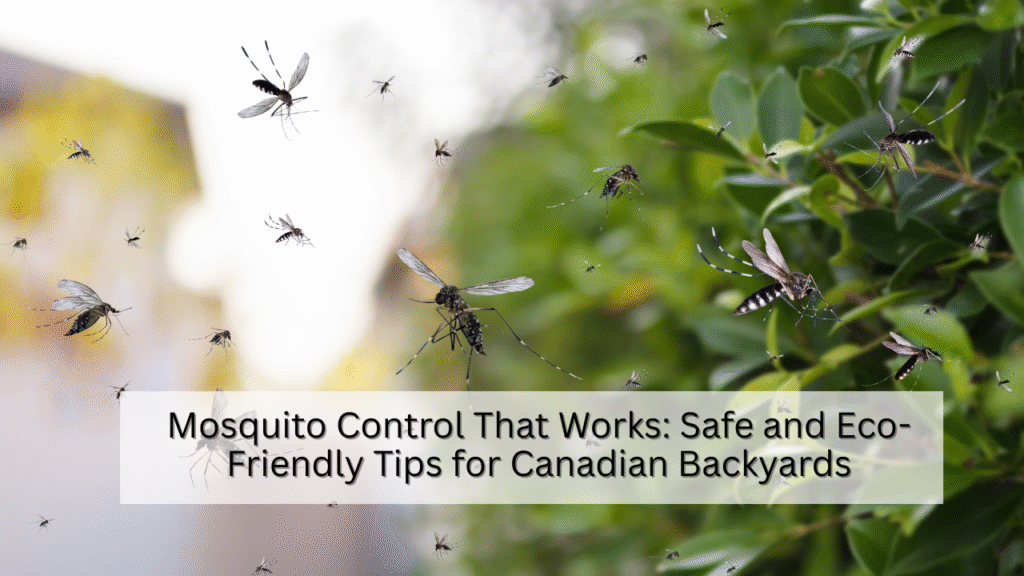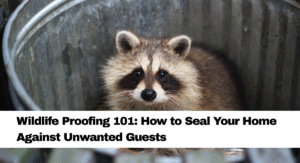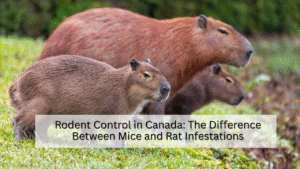It’s a warm summer evening. You’ve just settled on the patio with a cold drink and within minutes, you’re swatting the air like you’re signaling for help.
Yep. Mosquitoes.
They show up quietly, bite fast, and leave you itching for days. But beyond being annoying, mosquitoes in Canada can carry viruses like West Nile. Keeping them under control isn’t just about comfort, it’s about health and peace of mind.
The good news? You don’t need harsh chemicals or foggers to enjoy your backyard. With a few smart steps, you can make your outdoor space mosquito-resistant, safely and effectively.
Let’s walk through what works, what doesn’t, and how to build a mosquito-free zone around your home.

Why Mosquitoes Love Your Backyard
If mosquitoes seem to prefer your yard, it’s not personal, it’s environmental.
They’re drawn to three things: water, warmth, and breath.
- Water: Female mosquitoes lay eggs in standing water, even tiny puddles, flower pots, or clogged gutters.
- Warmth: They thrive in humid, warm air, especially near plants and shaded spots.
- Breath: Carbon dioxide from humans and pets helps them track their next meal.
Basically, your backyard is a buffet if you’re not careful.
The Real Problem With Mosquitoes
Besides itchy bites, mosquitoes are known carriers of diseases like West Nile Virus, which appears in Canada each summer.
Even though most bites are harmless, repeated infestations can make outdoor spaces unusable, especially for families, pets, and small children.
And here’s something people often overlook: mosquitoes don’t travel far.
Most species live and breed within 100 metres of where they hatch. That means if you’ve got them, they’re probably breeding somewhere nearby, often in your own yard.
Step 1: Find and Eliminate Standing Water
This is the single most important step.
Mosquitoes need standing water to breed and their eggs hatch in as little as five days.
Walk around your property once a week and look for any water that doesn’t drain naturally.
Common breeding spots:
- Clogged gutters and downspouts
- Old tires or buckets
- Pet bowls or birdbaths
- Plant saucers
- Children’s toys or wading pools
- Trash can lids
Empty and scrub them often. If you can’t remove the water (like in ponds or rain barrels), add mosquito dunks — small tablets that kill larvae without harming birds, pets, or plants.
Step 2: Keep Your Lawn and Plants in Check
Mosquitoes rest in tall grass and dense shrubs during the day. Keeping your yard tidy helps reduce hiding spots.
Mow the lawn regularly.
Trim bushes, hedges, and low branches.
Remove leaf piles and compost near patios.
If you have thick vegetation around fences or sheds, consider planting mosquito-repelling plants nearby, like citronella, lavender, basil, or marigolds.
They won’t drive mosquitoes away completely, but they do help reduce the number hanging around.
Step 3: Use Natural Repellents That Actually Work
You don’t need to fill the air with chemicals. A few natural options can make a noticeable difference.
1. Essential Oil Sprays
Mix a few drops of lemongrass, peppermint, or eucalyptus oil with water and a bit of witch hazel.
Spray around doors, patios, and outdoor seating areas before guests arrive.
2. Citronella Candles or Torches
Citronella masks the scent of carbon dioxide and sweat, making it harder for mosquitoes to find you.
It’s great for small patios, but not as effective for large open yards.
3. Outdoor Fans
Simple but powerful. Mosquitoes are weak flyers, so a steady breeze from a fan can keep them away during outdoor meals.
4. Mosquito Traps
Battery-powered traps that use light, heat, or CO₂ attract mosquitoes and trap them before they breed.
They’re safe, quiet, and chemical-free — just make sure to clean them regularly.
Step 4: Protect Yourself When You’re Outdoors
Even if you’ve done everything right, you’ll still encounter mosquitoes occasionally. Here’s how to protect yourself safely.
- Wear light-coloured clothing: Mosquitoes are drawn to dark shades.
- Avoid heavy perfumes: Sweet scents attract them.
- Apply repellent: Choose DEET-free sprays with picaridin or oil of lemon eucalyptus for natural protection.
- Use screen tents: For picnics or outdoor parties, mesh tents create instant safe zones.
A little preparation makes your summer evenings a lot more peaceful.
Step 5: Light and Landscaping Matter
Mosquitoes use light to navigate — and not all lights are equal.
- Replace bright white bulbs with yellow “bug lights.” They’re less attractive to insects.
- Avoid overwatering your garden — wet soil invites mosquitoes.
- If you have a pond, add fish like goldfish or koi. They eat mosquito larvae naturally.
And for patios, consider cedar mulch. Its scent helps deter mosquitoes and other bugs.

When to Call a Professional
If mosquitoes are ruining your summer despite your best efforts, there’s probably a breeding site you can’t reach — under decks, in drains, or on neighbouring properties.
Professional pest control technicians use targeted fogging treatments and larvicide applications that focus only on problem areas — not your whole yard.
It’s quick, safe, and eco-friendly when done properly.
At BugManagers, we use environmentally responsible mosquito control methods across Ontario.
Our approach targets both adult mosquitoes and breeding larvae, reducing the population without harming beneficial insects like bees or butterflies.
A technician can identify hidden breeding spots you might miss and set up a prevention plan that keeps your yard comfortable all season long.
Eco-Friendly Doesn’t Mean Ineffective
Some people assume “eco-friendly” means “less effective.” That’s not true.
Modern mosquito control combines biology and smart prevention — not just chemicals.
For example:
- Bacillus thuringiensis israelensis (BTI), found in mosquito dunks, is a naturally occurring bacteria that kills larvae but is completely safe for pets, fish, and humans.
- Insect growth regulators (IGRs) stop larvae from becoming adults without using poisons.
- Thermal fogging uses plant-based oils that repel rather than kill, reducing environmental impact.
So you can protect your family and the planet at the same time.
How Often Should You Treat Your Yard?
Mosquito populations grow fast in summer, especially after rain.
For long-term relief, plan for treatments every 3 to 4 weeks during peak season (May–September).
If your property borders ponds, woods, or ditches, you may need more frequent checks.
And if you’ve had water damage or flooding recently, schedule a quick inspection — mosquitoes can breed in unexpected places after heavy rain.
A Note About Safety and Pets
If you’re using any spray or repellent, read the label carefully.
Even natural products can irritate pets if overused.
Keep dogs and cats indoors during yard treatments.
Let sprays dry before letting them back out.
Avoid applying repellent directly to their fur unless it’s made for pets.
Professional treatments from BugManagers are safe for animals, kids, and plants — we only use approved products designed for residential use.
Final Thoughts
You don’t have to surrender your summer to mosquitoes.
With a few mindful steps — removing water, trimming plants, and using safe repellents — you can reclaim your backyard and enjoy your evenings again.
The key is consistency. Check for standing water weekly, treat before summer hits full swing, and keep your space clean and breezy.
And if you’ve tried everything and the mosquitoes still win?
That’s when BugManagers steps in.
Our team provides eco-friendly mosquito control across Ontario — protecting your home, your family, and your time outdoors.
From small backyards to large properties, we’ll make sure mosquitoes stay out of your summer plans.
Because outdoor memories should be about laughter and barbecue — not bites.







